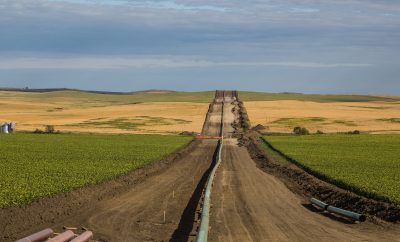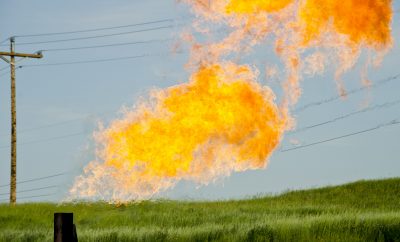 "Pipeline on rails, Trempealeau WI" courtesy of [Roy Luck via Flickr]
"Pipeline on rails, Trempealeau WI" courtesy of [Roy Luck via Flickr]
Energy & Environment
What’s the Best Way to Transport Crude Oil?
In the past 20 years, fuel has been the fastest growing export in the world, both in terms of volume and value. Oil makes up a huge portion of these fuel exports and is also the primary energy source for transportation throughout the world. Currently, the only alternatives to oil for the transportation sector are electric and hydrogen cell powered cars. Both of these are comparatively very small industries and only act as energy alternatives to on-road vehicles, while the transportation sector also includes all the world’s ships, planes, and military vehicles, which are all heavily dependent upon petroleum. As of now, oil is here to stay on planet earth, whatever its consequences may be.
Oil production in the United States has changed a lot in recent years. Following the discovery of the Bakken Shale formation in North Dakota and Montana, the United States increased its domestic production dramatically. The Bakken formation combined with the Eagle Ford and Permian Basins located in Texas allowed the U.S. to produce 66 percent of its oil domestically in 2014. The discovery of the Bakken Shale was hailed by some as an incredible discovery that will allow the United States newfound energy independence. But an equal number of people have objected furiously to our exploitation of the shale patch, claiming that it only further solidifies the United States on a path toward fossil fuel dependence. Our domestic production has decreased somewhat in the last two years as oil prices have dropped abroad, but overall our production rates are higher than they have been in a very long time and there is a considerable push to continue strengthening the industry domestically.
Now that a greater quantity of oil is being produced on the U.S. mainland than before, the amount of oil being shipped via tanker to the United States has dropped dramatically, which means that globally the risk of ocean oil spills has decreased as well. However, transporting oil domestically poses its own environmental problems and even imported oil often needs to be shipped to different parts of the country by land transport. If oil spills on the mainland, it can destroy ecosystems and watersheds and render communities unstable. If oil catches fire, it can lead to gigantic explosions, a few of which have historically had terrible consequences for American towns. Read on to learn about the pros and cons of different methods of oil transportation and the policy fights involved.
Rail
Currently, the most common method of oil transport is by railway. Truck transport of oil now only accounts for 4 percent of all petroleum moved because of its high level of inefficiency and risk. While pipelines can often be more efficient modes of transport, their construction can lead to political battles. The advantage of rail transport is that the infrastructure is already in place and already spans across America–all it needs is to be re-utilized.
Many railroads owners are willing to sign contracts with crude oil companies that allow for their railways to be used for transporting oil. Often these contracts are short term and many railway owners reserve the ability to withdraw from the business relationship later down the road. The railway transport business has grown exponentially along with the upward spike in oil extraction. Only 9,500 carloads of oil were moved on freight lines in 2008; by 2013 435,560 carloads of oil were moved, equivalent to 300 million barrels of oil.

“Crude Oil Storage on Stilts” courtesy of Anthony via Flickr
However, this increase in railway transport has led to an increase in the risk of oil-related disasters. When a train transporting oil (also known as a “bomb train”) runs into a problem, it generally causes the oil to ignite, which results in an explosion. These explosions can be gigantic in size and result in large scale destruction. While railway movement is considerably safer than trucks in terms of land transportation, a single incident can have disastrous effects. This is further compounded by some evidence suggesting that Bakken shale produces a more flammable crude oil because of its specific mineral content. Because of North Dakota’s location in the very center of America, these bomb trains have to span incredible distances to move oil to the coasts of the country, which increases the risk that something may go wrong. Between 2013 and 2015 more than 10 major explosions took place in America.
The explosions can have devastating immediate effects, but oil leakage also poses its own risk. In 2013 alone more than 1.15 million gallons of oil were spilled. Oil leaks can take a considerable amount of time to clean up and the damage can happen very quickly. Oil is mostly made up of a combination of thousands of different hydrocarbons and is generally toxic to almost every living creature. Crude oil, in particular, is oil in its least processed form and poses a greater risk than refined petroleum to an area it enters and contaminates. Because of this, an oil spill can cause tremendous damage to an ecosystem. Furthermore, an oil spill in the ocean will eventually go away, partially through evaporation and partially through breaking down and falling to the ocean floor as an inert tar. However, if oil enters freshwater it can permanently render it undrinkable, which can be particularly serious in areas where humans live nearby and rely on freshwater for drinking water.
Pipeline Alternatives and the Keystone XL Expansion
Right now Canada is the largest U.S. supplier of foreign oil, which offers a certain level of ease of transport because the two countries are on the same landmass. Currently, 70 percent of petroleum products in Canada and the United States are shipped via pipeline. A certain amount of crude oil can be moved over the border on the Canadian Pacific Railway and Canadian National Railway, but there’s been a huge push to connect the two countries via new and larger pipelines. Pipelines would dramatically expedite the process of oil movement by making it both quicker and cheaper, and many argue that it would make the process dramatically safer for Canadian and American communities.

“Trans Canada Keystone Oil Pipeline” courtesy of shannonpatrick17 via Flickr
Much of the argument around pipeline transport has focused on the construction of the Keystone XL Pipeline expansion, a gigantic pipe system that would in theory run 1,661 miles between Alberta, Canada and Illinois. The oil giant TransCanada proposed Keystone XL in September 2008 and estimated that it would cost about $7 billion to create. Most of the labor force that would go into its design would be from the United States, creating up to 20,000 new jobs. It would also generate about $585 million in taxes for the states it ran through and over $5.2 billion in property taxes over the course of its functional lifetime. Many saw the pipeline as an incredible chance to increase energy security and to generate new job opportunities. An equal number of people opposed the movement, saying it only put the United States at greater risk of leaks.
There are others who support the pipeline from an environmental/human health perspective. It’s important to remember that while one can object to oil as an energy source in theory, we still very much need it to live our normal lives. Oil transportation will happen one way or another, and pipelines are generally thought as being safer than trains and therefore the lesser of two evils. However, the distinction really depends on how you measure safety. If you use damage to human life and property as your metric, then trains are the far more dangerous method of transportation because they can generate large explosions. When something goes wrong on a train, the damage is immediate and severe. However, a leak from a pipeline can last indefinitely and may even go unnoticed, pouring a continuous stream of oil into the surrounding areas. Because of this, pipelines cause a much greater level of oil spillage overall than trains and may have a much more severe impact on the environment.
Keystone Pipeline Debate
There was a lot of opposition to the construction of the Keystone XL pipeline from environmentalists as well as worried community members who felt that their areas would be endangered by potential spills. A large portion of the public opposition to the pipeline has come from Native American communities that live in the states the pipe would run through. Several Native American groups in Nebraska especially have argued that the location of the pipeline directly endangers the Ogallala Aquifer, which sustains huge numbers of people and a thriving agricultural business. The sheer length of the pipeline is also alarming to many; while it ends in Illinois, the crude oil will then be processed in-state and shipped south via existing pipelines all the way to the Texas coast. This means that gigantic streams of crude oil would constantly be moving across the center band of the United States.

“pipeline” courtesy of Ripperda via Flickr
TransCanada argued that the pipeline would be built with state-of-the-art safety equipment, including over 16,000 smart sensors along its body, to allow for the quick relay of any problems and relevant information to repair teams. These sensors deliver information to satellites, which then dispatch emergency response crews that are located along the pipeline in each state. This level of security is particularly important because the Keystone XL would transport pre-processed crude oil to refineries. Crude oil is so thick that it has to be continuously heated in order to flow properly, which increases its volatility in the event of a spill.
Four years after it was initially proposed, President Obama rejected the Keystone XL expansion presidential permit in 2012. Not to be deterred, TransCanada began to explore alternative methods of building the pipeline and working closely with Nebraska, which led to the submission of another presidential permit less than half a year after the original rejection. The Obama Administration spent several years refusing to make a final decision on the expansion, saying that while it supports the pipeline’s ability to spur business and create jobs, it wouldn’t make a decision that will cause an increase in greenhouse gas emissions.
In November 2015, President Obama made the final decision to reject the Keystone XL pipeline, claiming that the benefit it would have for the economy in the long term wouldn’t outweigh the damage it would do to U.S. energy security and the country’s role as a progressive energy leader. TransCanada responded by asking for a delay on the review of the Nebraska route, which most likely would have pushed the final decision back for another indefinite period of time. This most likely would have placed the power of approving or rejecting Keystone XL in the hands of the winner of the 2016 Presidential race. However, the Obama Administration rejected this as well, ending the battle over the Keystone XL once and for all.
Conservatives were mostly furious and environmentalists were generally overjoyed. However, from a public health perspective, it isn’t completely clear what impact this decision will have. The risk of oil pollution will decrease but railway oil transportation and its dangers will remain prevalent instead. Furthermore, a large part of the argument from pipeline supporters is centered around energy security; increasing oil imports from Canada is viewed as a much safer business deal than increasing them from the Organization of Petroleum Exporting Countries, for instance. With the pipeline abandoned, it’s possible that the next energy argument will center around increasing oil extraction from U.S. reserves back to their 2014 levels and beyond, which would increase energy independence but also cause greater damage to the U.S. ecosystems and communities.
Conclusion
No method of oil transportation is completely safe, and different methods have their own advantages and disadvantages. Boats are generally the safest method for moving oil but have the greatest possible impact on the environment when they do actually spill. Oil movement on land is a completely different issue because it involves areas where humans live. While oil spills from trains result in higher levels of human death and property destruction, oil spills from pipelines are more common and often more severe, with longer lasting effects on the environment.
The extreme position is to fight against all forms of oil transportation under the argument that every resource dedicated towards oil industry infrastructure takes away from resources that could go to more progressive transportation technologies, such as electric cars and hydrogen fuel cells. Currently, the world is nowhere near ready to wean itself completely off oil, but competitor transportation technologies have steadily grown larger and larger in the past decades.
It’s important to remember that none of these alternatives are perfect and completely environmentally friendly–electric cars require large-scale mining operations to access the lithium iron for their batteries, for instance. However, overall a shift toward non-fossil fuel based transportation alternatives would still dramatically reduce global emissions. The world may not be technologically prepared to survive without oil, but as long as we depend on it, oil transportation and its risks and dangers will always be a factor in our lives and communities.
References
Americans for Tax Reform: A Brief History of the Keystone XL Pipeline
Aljazeera America: A History of Keystone
Forbes: Pick Your Poison for Crude: Pipeline, Rail, Truck or Boat
The Hill: Obama Rejects Keystone Pipeline
Institute for 21st Century Energy: Background of Keystone XL
Oil 150: Early Oil Transportation: A Brief Transportation
RiverKeeper: Crude Oil Transportation: A Timeline of Failure
RT: What’s the Hold Up? Still no Decision on Keystone XL Nearly 7 Years Later
Scientific American: The Ogallala Aquifer: Saving a Vital U.S. Water Source
Sightline Institute: Oil Train Explosions: A Timeline in Pictures
U.S. Rail Transportation of Crude Oil: Background and Issues for Congress
The Des Moines Register: Corps: We’re Not For or Against the Bakken Pipeline
World Trade Organization: International Trade Statistics: World Export for Commercial Services








Comments